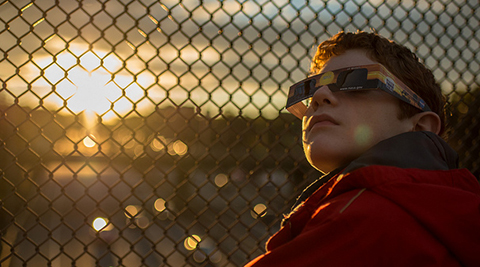Here in Los Angeles, we’re known for the sun. We get a lot of it. It’s long been a selling point for people moving to the region.
But what if the sun were to disappear from the sky? What would Los Angeles be like? Why would this happen?
Fortunately, the sun is not going to disappear from the sky anytime soon. But on rare occasions, the moon moves in front of the sun in such a way to darken the sky and turn day into night for a few minutes. Most of you who haven’t given up on this, know this as a solar eclipse.
Unless you have been living in some place where there is no sun, you’re probably aware that there’s a solar eclipse coming up on August 21, 2017. And it’s no small matter.
The total eclipse of August 21 is called by some “The Great American Eclipse” because the path of totality will go through a wide swath of the country. And it will go through places like Oregon (but not Portland), Jackson Hole, parts of Kansas City and St. Louis, Nashville, and Charleston. If you want to see a total solar eclipse, this is your best chance. Or might have been, as most places in the path of totality have had hotels booked up for years. (Unless you’re one of those people who owns a Lear jet and flies to Nova Scotia to see them. Kids, ask your parents about this reference. While you’re at it, I have a lot of other questions about that song, but they aren’t pertinent to this.)
What is the sensation of a total solar eclipse? Is it something that can make us feel something more than what we see in a YouTube video of a cat getting stuck in a bag? Yes, it is. Author Annie Dillard wrote about a total solar eclipse she saw back in the 1970s in her book Teaching a Stone to Talk. She compared seeing a partial solar eclipse as opposed to a total one as “flying in an airplane as opposed to falling out of one.”
If you’re not interested in taking a trip in mid-August to watch the sky go from light to dark for about 2 ½ minutes, you can get a partial experience in Los Angeles. (The last total solar eclipse visible in Los Angeles was on May 22, 1724. And it lasted nearly 4 minutes!) At its peak, the sun will be around 60% eclipsed on August 21. Which will be somewhat cool, but it won’t be totally cool. You’ll still need the special glasses that the library is giving away at places that are having eclipse watching programs. Eclipse glasses for safe viewing will be available only for event participants, on a first-come, first-served basis, while supplies last.
If you miss this total solar eclipse, you can try again on April 8, 2024, which will be total in parts of the Eastern United States (and under 50% in Los Angeles). But take heart that it’s estimated that each spot on the planet gets to see a solar eclipse every 360 to 410 years. Perhaps you can just plan on living that long. I wouldn’t assume that, but maybe you’re feeling lucky. Or maybe you’ll live that long, but on the day of the eclipse it will be cloudy. Nevertheless, the sun abides.

